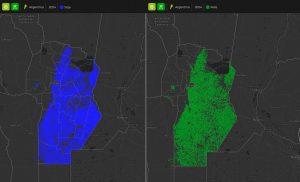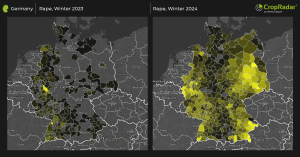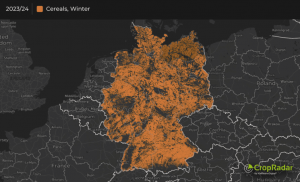
CropRadar from Kleffmann Digital RS has measured the rapeseed areas cultivated in the top 10 countries. In January 2024, less than 6 million hectares of oilseed rape can be found in these countries (including the UK). In Ukraine, which is analysed separately, a significant decline in cultivation areas can be observed.
Europe – After a record year for oilseed rape cultivation, CropRadar, a leading system for satellite-based detection of plant types and acreage, has recorded an overall decline in rapeseed acreage in Europe this year. Despite regional differences, there is a clear trend: the upward trend for rapeseed has been broken. The total area under cultivation has thus returned to the average level of the last five years. Countries such as the United Kingdom, Romania, and Denmark recorded the largest declines compared to the previous cultivation year. In these regions in particular, the market situation and unfavourable weather conditions in some cases prompted farmers to plant less rapeseed.
Germany and Austria only recorded slight losses. Regional analyses show the largest decline in Schleswig-Holstein with a drop of 10.2 % compared to the previous year, while an increase in rapseed acreage was observed in the smaller western German states. Extreme weather events at the end of last year and the beginning of this year suggest a further decline in acreage, the extent of which is still to be determined.
In France, on the other hand, CropRadar recorded a slight increase in rapeseed acreage of just under 2%. Despite falling prices, the very good harvest and sowing conditions have encouraged French farmers to further expand the area under cultivation.
In Poland, the third-largest rapeseed producer in the EU, a reduction in the area under cultivation is also expected, although the 1-million-hectare mark will be narrowly exceeded again.
The data on oilseed rape acreage in the Ukraine show significant declines with some large regional differences, especially in the southern regions such as Odessa and Mykolaiv, where the acreage is approaching the 2022 level again.
“The latest data from CropRadar clearly shows how dynamic the European rapeseed market is. Despite regional differences, a general trend towards fewer rapeseed cultivation areas is visible,” states Dr Frederike Lülfs-Baden, agricultural economist at Kleffmann Digital.
In the following months, possible weather-related changes will become even more apparent, meaning that the area under cultivation for harvesting may still change over the course of the growing season.
Rapeseed prices are currently back at the level last seen at the beginning of 2021. They have thus returned to the price level that existed before the start of the price rally between 2021 and 2023. However, compared to 2021, when only two countries reported a cultivation area of more than 1 million hectares, four countries are now maintaining their cultivation level at over 1 million hectares.
- General



